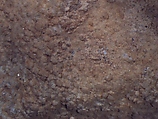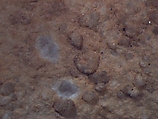On loan to The Met The Met accepts temporary loans of art both for short-term exhibitions and for long-term display in its galleries.
Marble female figure
Technical analysis: Multiband imaging, optical microscopy, X-ray fluorescence spectroscopy, Raman spectroscopy, X-ray diffraction
The figure is complete except for a small loss from the proper left foot [check]. The neck has been broken in two places and rejoined. A thin yellowish-orange patina is visible throughout and adheres poorly to a heavily worn surface characterized by a strong differential dissolution of calcite grains A flat-topped circular polos or tall headdress crowns the oval-shaped head, whose distinguishing features consist of deep-set eyes, which were sometimes inlaid, a prominent nose, a horizontal groove delineating the mouth, and large ears, most evident from the side and back. The elongated neck is defined by a v-shaped groove at the base on the front. The back has a long groove for the spine and full buttocks. The small arms are bent at the elbows and held up to the small breasts, which are not clearly distinguished from the hands. The belly button is placed at the center of the figure, her stomach gently rounded above the pubic area, which features a prominently incised vulva. She stands with large, wide hips on straight legs, whose knees and calves are carefully modeled. The feet are arched and the toes indicated by incisions, most visible on the right foot.
The figure represents the well-developed Plastiras type, one of the most distinctive of the Cycladic sculptural forms created in the Early Cycladic I period. The sculptor was clearly accomplished and from the carving alone, the sculpture compares quite well with other known examples of the type, albeit exceptionally well-preserved and larger than average. Nonetheless, there are differences that could be attributed to an ancient sculptor’s idiosyncrasies, such as the narrow shoulders and wide hips; however, in our opinion, these differences are more likely to be subtle features created by a modern forger in an attempt to make the sculpture appear more appealing to contemporary eyes. The sculpture shares stylistic affinities with an ancient Cycladic sculptor, identified as The Metropolitan Museum Sculptor, and it is likely that the present work was influenced by the work of that artist, and the name piece of that sculptor may have served as its model.(1) Of particular concern is the state of the surface of the marble, which exhibits homogenous weathering throughout without any directionality or relative orientation of the object in a burial environment. Likewise, its iron-rich patina is very thin, and consists of loose, fine crystals of calcite deposited around and within the dissolved marble grains Although this type of differential weathering is not necessarily a definitive evidence of artificial treatment, the isotropic dissolution of the marble, the homogenous deposit of fine, poorly consolidated calcite crystals, and the thin iron-oxide film on the surface of the marble point towards an artificially created surface rather than to a naturally weathered one. It is not possible to exclude that the figure was heavily cleaned with a combination of chemical and mechanical treatments that completely altered the original surface of the stone, leaving behind a heavily etched marble.
Seán Hemingway, Dorothy Abramitis, Federico Carò
(1) Physical copies of the Plastiras figure in the Met collection (MMA accession number 45.11.18) were available as early as the 1970’s and could have served as a model for this piece.
Due to rights restrictions, this image cannot be enlarged, viewed at full screen, or downloaded.
This artwork is meant to be viewed from right to left. Scroll left to view more.









